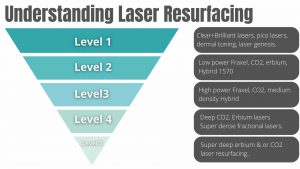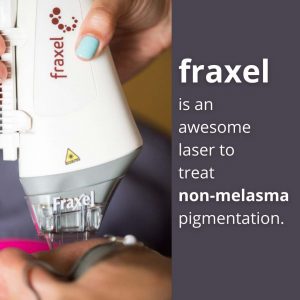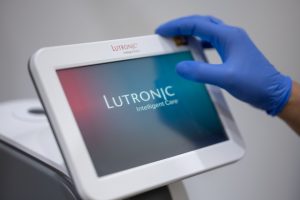Fraxel Laser Brisbane
Fraxel is a time-tested fractional laser that can improve skin texture, reducing age spots, pigmentation, fine lines, wrinkles & enlarged pores.
Fraxel Skin Series Summarised
- This intermediate skin renewing series improves skin quality & provides reliable reproducible results
- Fraxel addresses fine lines, enlarged pores, sun damage & pigmentation
- It is best used to treat lighter skin types
- A series of 3 sessions is performed, 4 to 8 weeks apart
- Recovery can be tailored from 2 to 5 days

What is Fraxel Laser?
Fraxel is a form of fractional laser resurfacing. This treatment uses precisely delivered light energy to target specific skin concerns. Every aspect of treatment can be tailored to the patient, including depth of penetration, coverage & intensity of each treatment.

What does Fraxel laser treat?
Fraxel laser is best for changes that occur on the surface of the skin, namely fine lines, enlarged pores, sun damage, & pigmentation.

How do I know if Fraxel is the correct treatment for me?
Book a consultation with my nursing team at Cutis Dermatology in Brisbane for an assessment.
For Sydney patients, book an appointment with Louise at Clinic DVP. We use the LaseMD Ultra which is similar to Fraxel.
How many sessions will I require?
3 sessions are the sweet spot. This provides the best balance between clinical results & skin recovery. Sessions are typically spaced 4 to 8 weeks apart.
How long does each Fraxel laser session take?
Lasing time takes 15 to 25 minutes, whilst numbing application time is under one hour.
Is it painful?
Treatments are well tolerated as we use skin cooling in addition to specialist prescribed numbing gel.
What is recovery like?
Uneventful. As this laser can be customised for each patient, downtime varies between 2 to 5 days. Unlike micro needling, fractional laser resurfacing does not cause bleeding or bruising, so you recover much faster. As a guideline-
Day 0-1: redness & swelling
Day 2-4+: flaking with reducing redness over each day
Who performs this procedure?
Our dermal clinicians & nurses perform Fraxel, as this is a light to medium level laser. Over the past 16 years we have performed over 5,000 Fraxel laser treatments. Our dermatologists are one of the most experienced in the world, in fact they helped write up the international Fraxel protocols.
In Sydney I work closely with our dermal clinician, Louise at Dr Van Park’s clinic in the Eastern Suburbs.

Is Fraxel safe in darker-ethnic skin types?
Yes, however there are much better solutions for ethnic skin patients. Pico lasers are better at clearing pigmentation & improving skin quality in Asian patients. They offer a higher clearance rate, less downtime & superior safety margin as this laser is specially made for darker skin. We use the Picoway & Picosure Pro lasers.
Does Fraxel interact with Botox or dermal fillers?
No. Fractional lasers do not go to the same depth as dermal fillers & biostimulatory injectables like Biostimulators. They do not melt these agents. The same goes for Botox.
Does Fraxel treat acne scars?
Yes, but there are many better treatments for acne scars. As we have over 40 laser & energy devices, we provide the best solution for our patients & do not follow the ‘cookie cutter’ services of many other clinics. For acne scars, better solutions include-
- Fractional CO2 laser: eCo2, Ultrapulse, Mixto, CO2CORE
- Hybrid lasers: Alma 1570 + CO2
- Erbium lasers: ProFractional
- RF miconeedling: We use Secret RFM, Genius RF, & Potenza
What treatments have less skin recovery compared to Fraxel?
There are 2 ‘step down’ treatments from Fraxel. These treatments do not produce the same results, but they have ½ the downtime as Fraxel laser.
- Clear & Brilliant fractional laser: 4-6 sessions required for best results. Skin recovery ranges between 1-3 days.
- Secret RF & Potenza RF: 3-4 sessions required; recovery is within 1-2 days.

What are the potential side effects of Fraxel?
Fraxel is considered a light to medium resurfacing laser & has a very good safety profile. Side effects are rare, but include-
- Flare up of pre-existing rosacea: anything that puts heat into the skin care flare up rosacea. Your clinician will discuss vascular lasers & oral anti-inflammatories to reduce this flare up if you are prone to rosacea.
- Flare up of pigmentation due to melasma: sub-clinical melasma can be unmasked by Fraxel & other fractional lasers.
- Skin infections: include flare up of HSV or cold sores & bacterial infections.
- Scarring: is exceptionally rare (less than 0.1%) & is usually due to infection.

What is the difference between Fraxel & Morpheus8?
Moprheus8 is an RF micro needling device that is used to treat the dermal & fat layer of skin. It is best used to contract dermal collagen, but it is not as efficient as Fraxel at treating textural issues such as fine lines, wrinkles, pigmentation, pores & sun-damage.
What is the difference between Fraxel & micro needling?
It’s like comparing the newest iPhone with a Motorola phone of the 90s. Micro needling is an entry level treatment that can be beneficial for mild textural changes. With a little instruction it can be safely performed as a DIY treatment in the comfort of your home using 0.2 to 0.3 mm needles.
Laser resurfacing uses pin-point precise wavelengths of light to specifically target key elements within the skin including pigment, collagen, & blood vessels. That’s the very simple explanation, the more complex one is termed ‘selective photo thermolysis’. Google it.

What is the difference between Fraxel & HIFU- Ultherapy?
HIFU or high intensity focused ultrasound treats under your skin, whist Fraxel treats the surface of your skin. HIFU is best used to contour your skin, namely, to reduce unwanted pocket of facial fat- especially of the lower face. In some cases, it can produce mild to moderate skin tightening.
Do I use Fraxel laser at Clinic DVP in Sydney?
At Clinic Dr Van Park in the Eastern Suburbs of Sydney, we use a similar (but newer) fractional laser called the LaseMD Ultra. Compared to Fraxel this has a neater delivery of laser beams & has a slight advantage when it comes to power. Clinical results are identical with this newer laser.

Davin’s viewpoint on fractional laser resurfacing for skin rejuvenation
The algorithm for low downtime skin rejuvenation in lighter skin types is simple- namely the non-ablative 1927 wavelength. This wavelength is superior IMO for textural change rejuvenation as compared to the 1550, however the later can be useful for acne & traumatic scars.
The question now is- which is the best laser for the job? I have access to both 1927 thulium Fraxel & the Lutronic LaseMD Ultra. Here is the summary-
- Both devices are excellent, & far better than any other competitor in the market as of 2023. This includes devices from Candela & Sciton.
- The Fraxel is faster by 15 ish percent
- The LaseMD has a better & neater beam profile & is marginally more powerful
- The clinical results are comparable
Fraxel laser is best used on lighter skin types- purely based upon the biology of darker skin types & the target chromophore of water. Not that it cannot be use on Asian & ethnic skin, but there are far, far better options for pigment rich ethnic skin, namely Picoway & Picosure Pro lasers.
Fraxel & melasma or post inflammatory hyperpigmentation? Yes, I am aware of the papers, but again, there are far better options for melasma. As compared with pico lasers, Fraxel (in the context of melasma) is-
- Has more downtime (24 to 72 hours)
- Has more pain (requires numbing)
- Has a higher PIH & rebound rate compared to pico lasers
- Cost 2-3 times more to perform compared to pico lasers
- Is not as effective as Picosure to clear pigment
